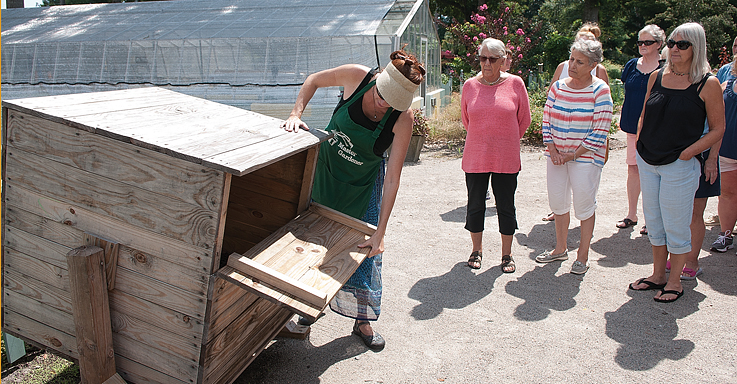Both experienced farmers and novice gardeners learned how to turn table scraps into nutrient-rich soil during a compost workshop hosted by the New Hanover County Arboretum on Friday, Aug. 21.
Composting is the process of converting organic waste into nutrient-rich fertilizer. Dave Silvia, who co-owns Centripetal Farms with three other farmers and was one of the presenters at the Compost 101 workshop, said people have used it since the early Roman Empire.
Silvia began his presentation by passing around bags of shredded paper and vegetable dinner leftovers.
“These are compostable materials,” he said. “It’s turning organic matter into rich humus. It’s working with nature.”
Silvia said compost is particularly important in southeastern North Carolina.
“It’s a sand pit. We live in a giant estuary,” he said. “We need [to enrich the soil] and make it better.”
Compost is comprised of green materials, which are high in nitrogen, and brown carbon-rich materials. Green materials include grass clippings, eggshells, tea bags, aquarium water, seaweed, coffee grounds and filters; while yard trimmings, paper towels, toothpicks, cereal, crackers, pencil shavings sawdust and corn cobs are all brown compostable matter.
Silvia provided his recipe for methodical composting, a technique for layering green and brown materials in a compost bin.
“You want three inches of green, three inches of brown, stir and repeat,” he said.
Silvia recommended using a large tumbler to optimize the process.
“With a tumbler, you can turn it one time and you aerate it for the week,” he said.
Compost stirred with a tumbler is usually ready within three or four months, Silvia said. He also recommended putting compost bins or tumblers in direct sunlight, since heat and light will speed the process.
People who do not want to stir or layer their compost can simply put all their materials in a container outside and let them sit until they’re ready to be used, which will likely take nine to 12 months.
A compost pile is ready when the individual materials are no longer recognizable.
“When you can’t read the newspaper anymore, it’s ready,” Silvia said.
One woman asked if pecan shells and sunflower seed shells were compostable materials. Another woman asked about bird feathers.
“Absolutely,” Silvia said.
A third audience member asked if pesticides on unwashed fruits and vegetables would be detrimental to compost piles.
“Pesticides and other chemicals from unwashed material will be broken down by the bacteria in the compost,” Silvia said.
There are materials that are unsuitable for compost, including dairy products, meat, painted wood and pressure-treated lumber.
“Pressure-treated wood contains arsenic and copper,” he said.
Silvia concluded his portion of the workshop by describing various ways to use compost material, aside from agriculture. People can put it around trees and shrubs in their yards.
“You can put it in potted plants. If you don’t mind getting your hands dirty, you can stir it,” he said.
Matt Collogan, one of Silvia’s business partners at Centripetal Farms, said another important benefit of compost is reducing the amount of waste entering landfills.
“Forty percent of what goes into landfills is compostable material,” he said. “If we can divert that out of landfills, we won’t need another landfill in New Hanover County.”
The city of Raleigh allows residents to drop off yard waste for a fee at a recycling center and also purchase ready-to-use compost. Collogan encouraged everyone in the room to write local government officials about bringing a similar program to Wilmington.
Evan Folds, owner of Progressive Gardens, explained the bacterium that decomposes compost helps with disease control in plants.
“Pests, like moles, are attracted to unhealthy plants,” he said.
After three hours of classroom presentations, the last hour of the workshop took place in the arboretum. Heather Kelejian, the director of the facility’s Ability Garden — a therapeutic program — showed attendees the inside of a 3-foot wooden tumbler.
Kelejian then led the group into a shady area where she showed them the inside of her worm bin, a small plastic container. The worms digest the materials, aiding the compost process.
“You can put whatever you want in it,” she said. “Mine has dirt, leaves and a lot of coffee grounds.”
Kelejian held up an empty blueberry container and put a sheet of paper inside it, covering the holes.
“For teachers, this is a great activity,” she said. “Each kid can put a scoop of dirt in a container and take home a worm garden. When they get comfortable with it, they can move on to a bigger container if they wish.”
email [email protected]




